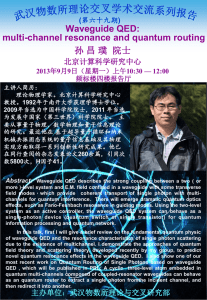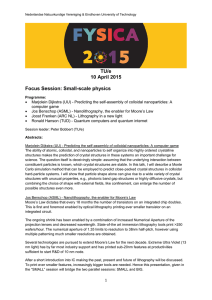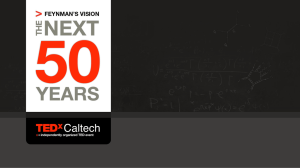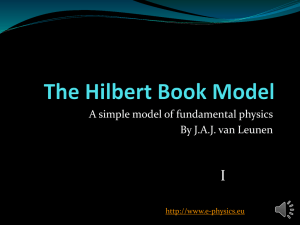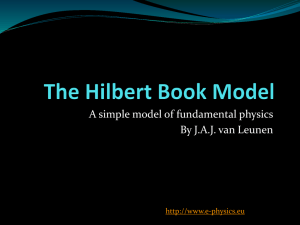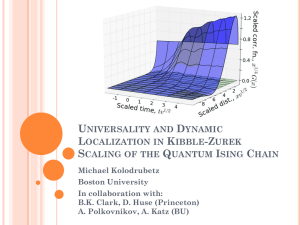View slides - New Perspectives on Thermalization
advertisement
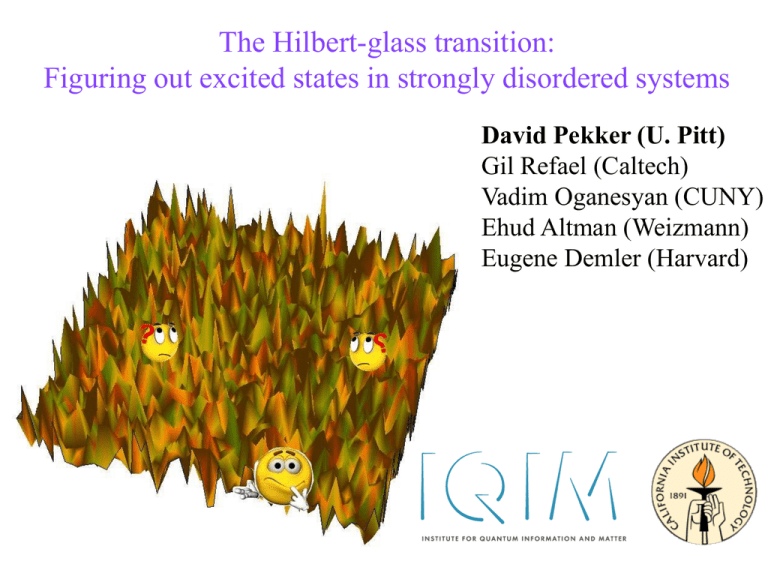
The Hilbert-glass transition:
Figuring out excited states in strongly disordered systems
David Pekker (U. Pitt)
Gil Refael (Caltech)
Vadim Oganesyan (CUNY)
Ehud Altman (Weizmann)
Eugene Demler (Harvard)
Outline
• Quantum criticality in the quantum Ising model
+ preview of punchline
• Disordered Quantum Ising model and real-space RG
• Extending to excited states – the RSRG-X method
• The Hilbert-glass transition
Standard model of Quantum criticality
• Quantum Ising model:
H J nz nz1 h nx
z
z
z
h
h J
z
z
x
Standard model of Quantum criticality
H J nz nz1 h nx
• Quantum Ising model:
z
z
z
z
z
x
h
• Phase diagram
T
h J
TQC ~ J h
z
Quantum critical
regime
Ferromagnet
Paramagnet
QCP
J h
Disordered Quantum Ising model
• Quantum Ising model:
z z
zz
• Phase diagram:
zz zz
x x
H J
h
h
n n n nn11
nn n
z
zz
T
z
z
x
TQC ~ J h
z
Quantum critical
regime
TQC ~ Exp J h
Ferromagnet
Paramagnet
QCP
J h
Surprise: Transition in all excited states
H J n nz nz1 hn nx
• Quantum Ising model:
z
• Phase diagram:
z
x
Hilbert glass
transition
T
typ ~
z
z
z
z
... ...
... ...
Or:
... ...
PM
[All eigenstates
doubly degenerate]
FM
QCP
J h
Surprise: Transition in all excited states
• Quantum Ising model:
z
x x
x x
J nnz
h
HH
J n
nnzz
h
J
'
1 n1 n n n n n n1
z
x
• Phase diagram:
z
x
x
Hilbert glass
transition
T
typ ~
z
x
z
x
z
z
x
... ...
... ...
Or:
... ...
PM
[All eigenstates
doubly degenerate]
FM
QCP
J h
Surprise: Transition in all excited states
• Dynamical quantum phase transition.
• Temperature tuned, but with no Thermodynamic signatures.
• Accessible example for an MBL like transition.
• Phase diagram:
Hilbert glass
transition
T
typ ~
x-phase
... ...
... ...
Or:
... ...
PM
FM
QCP
J h
Hilbert glass
phase
Disarming disorder: Real space RG
[Ma, Dasgupta, Hu (1979), Bhatt, Lee (1979), DS Fisher (1995)]
• Isolate the strongest bond (or field) in the chain.
J max1z 2z
• Choose ground-state manifold.
J max hleft , hright
• neighboring fields: quantum fluctuations.
E
Domain-wall
excitations
J max
1 2 , 1 2
hleft1x
hright 2x
1
Cluster
ground state:
1
2
J max
1 2 , 1 2
heff
2
hlefthright
J max
Disarming disorder: Real space RG
[Ma, Dasgupta, Hu (1979), Bhatt, Lee (1979), DS Fisher (1995)]
• Isolate the strongest bond (or field) in the chain.
• Choose ground-state manifold.
• neighboring fields: quantum fluctuations.
hmax 2x
hmax J left , J right
hmax
E
Anti-aligned:
2
J left1z 2z
1
Field aligned:
J right 2z 3z
2
hmax
2
3
1
X
2
J eff
J left J right
hmax
3
RG sketch
•Ferromagnetic phase:
J h
X
•Paramagnetic phase:
J h
X X
X
X
Universal coupling distributions and RG flow
• Initially, h and J have some coupling distributions:
(h)
(J )
hmax
h
J max
J
Universal coupling distributions and RG flow
• As renormalization proceeds, universal distributions emerge:
RG (h)
RG (J )
1
1
J 1 g J
1 g h
h
max{J , h}
h
g h , g J flow
with RG
J
• gh and gJ flow:
RG-flow
• These functions are attractors
for all initial distributions.
Paramagnet
QCP
0
Ferromagnet
ln J ln h
g J gh
What about excited states?
Pekker, GR, VO, Altman, Demler; Huse, Nandkishore, VO, Sondhi, Pal (2013)
E
• Put domain walls in strongest bonds:
J max1z 2z
• neighboring fields: quantum fluctuations.
J max hleft , hright
Domain-wall
excitations
hleft1x
J max
1 2 , 1 2
hright 2x
1
1
2
Excited
eff
h
Cluster
ground state:
J max
1 2 , 1 2
No effect on coupling magnitude!
2
GS
eff
h
hlefthright
J max
hlefthright
J max
What about excited states?
Pekker, GR, VO, Altman, Demler; Huse, Nandkishore, VO, Sondhi, Pal (2013)
hmax 2x
• Make spins antialigned with strong fields:
hmax J left , J right
hmax
E
Anti-aligned:
2
J right 2z 3z
J left1z 2z
1
Field aligned:
2
3
hmax
X
2
1
J
Excited
eff
2
• No effect on coupling magnitude!
J
GS
eff
3
J left J right
hmax
J left J right
hmax
RSRG-X Tree of states
• At each RG step, choose ground state or excitation:
[six sites with large disorder]
RG sketch
•Hilbert-glass phase:
J h
X
•Paramagnetic phase:
X X
J h
X
X
Excited state flow
• Universal distribution functions independent of choice:
RG (| h |)
RG (| J |)
1
1 g h
|h|
1
| J |1 g J
max{J , h}
h
g h , g J flow
with RG
J
RG-flow
• Transition persists:
X-phase
HGT
0
Random-domain clusters
Hilbert-glass
ln J ln h
g J g h / g J g h
Order in the Hilbert glass vs. T=0 Ferromagnet
• Symmetry-broken T=0 Ferromagnetic state:
... ...
Order parameter:
... ...
or
m GS nz GS
• Typical Hilbert-Glass excited state:
... ...
Order parameter:
mmEA
z
n
• Temporal correlations:
z z
nn
2
m (0) (t )
z
n
z
n
Order in the Hilbert glass vs. T=0 Ferromagnet
mEA
z
n
T
FM
Hilbert Glass transition
QCP
2
typ ~
... ...
... ...
J h
HGT
PM
J h
m GS nz GS
... ...
QCP
... ...
J h
T-tuned Hilbert glass transition: hJJ’ model
• Quantum Ising model+J’:
H J n nz nz1 hn nx J n ' nx nx1
1
z
x
2
z
x
3
• J’>0 increases h for low-energy states.
z
x
4
z
x
• But: No thermodynamic signatures
J ' J , h
5
1
T
X-states
• T (or energy-density) tuned transition
Hilbert
glass
J h
RSRG-X Tree of states
1
0
T
Energy
Color code:
inverse T
1
0
T
RG step
• Sampling method: Branch changing Monte Carlo steps.
RSRG-X results for the Hilbert glass transition
Flows for different temperatures:
Complete phase diagram:
~ hJ
Thermal conductivity
• No thermodynamic signatures – only dynamical signatures exist.
• Only energy is conserved: Signatures in heat conductivity?
Engineering
• assume scaling form: ( ) ~
Dimension:
3 | c |
Numerical tests
Summary + odds and ends
• New universality:
-T-tuned dynamical quantum transition.
- No thermodynamic signatures.
• Developed the RSRG-X
- access to excitations and thermal averaging of L~5000 chains.
• Excited states entanglement entropy:
- ‘area law’ in both phases
- log(L) at the Hilbert glass transition
(Follows from GR, Moore, 2004)
• Other Hilbert glass like transitions?
Edwards-Anderson order parameter
Lifshitz localization – a subtle example
• Tight-binding electrons on an irregular lattice.
Jn
• Density of states:
H n J n1 n1 J n n1
(E )
Pure chain:
Random J:
Ek 2J cosk
1
(E) ~
4J 2 E 2
(E) ~
1
E ln 3 E
Dyson singularity
E
Method of attack: Real space RG
Ma, Dasgupta, Hu (1979), Bhatt, Lee (1979)
• Reduced the largest bond
• Eliminated two sites.
• New Heisenberg chain resulting with new suppressed effective coupling.
J max
J left J right
J
2J max
J right
J left
2 3
1
1
2 3 2 3
2
4
Universality of emerging distribution functions
D.S. Fisher (1994)
J
1
2 3
4
5
6
• Functional flow and universal coupling distributions:
(J )
J max
J
7
8
Universality of emerging distribution functions
D.S. Fisher (1994)
1
2 3
5
4
6
7
8
• Functional flow and universal coupling distributions:
RG (J )
J g 1
1
g~
| ln J max |
0
J max
J
Random singlet phase
D.S. Fisher (1995)
1
2 3
4
5
6
• Low lying excitations: excited long-range singlets:
(E) ~
7
8
(E )
1
E ln 3 E
• Susceptibility:
1
1
(T ) ~
~
T ln 2 T / T0
T
Dyson singularity again!
Engtanglement entropy in the Heisenberg model
B
• Pure chain:
A
B
L
EAB
How many qubits
in A determined by B
EAB TrA A log2 A
(QFT Central charge, c=1)
1
log 2 L
3
Holzhey, Larsen, Wilczek (1994).
Vidal, Latorre, Rico, Kitaev (2002).
• Random singlet phase:
Every singlet connecting A to B → entanglement entropy 1.
EL
number of singlets
entering region A.
Engtanglement entropy in the Heisenberg model
B
• Pure chain:
A
B
L
EAB
How many qubits
in A determined by B
(CFT Central charge, c=1)
1
log 2 L
3
Holzhey, Larsen, Wilczek (1994).
Vidal, Latorre, Rico, Kitaev (2002).
• Random singlet phase:
Effective central charge
1
1
EL ln L ln 2 log 2 L
3
3
crandom 1 ln 2 1
GR, Moore (2004).
For the experts: Does the effective c obey a c-theorem? No…
Examples of enropy increasing transitions in random non-abelian anyon chains.
Fidkowski, GR, Bonesteel, Moore (2008).
Universality at the transition?
Altman, Kafri, Polkovnikov, GR (2009)
MG
BG
J g 1
RSG
RG (J )
Insulator
g=1
superfluid
1
g0 (~ J )
J
J max
Mechanical analogy
J1
J2
Average effective
Stiffness ~
spring constant
Jn
= 1 / J
1
(ave of inverse J)
0 when g=1.


